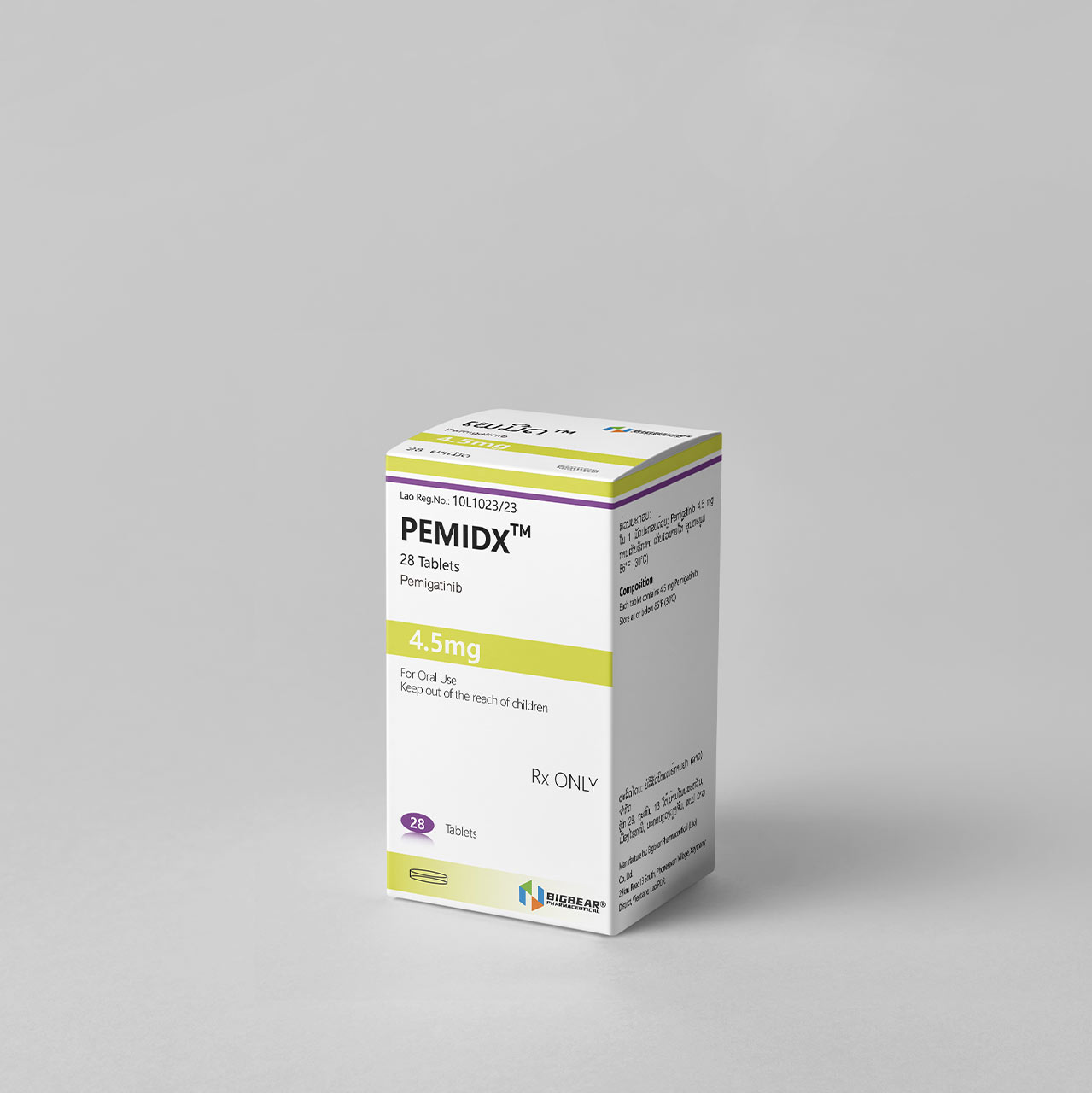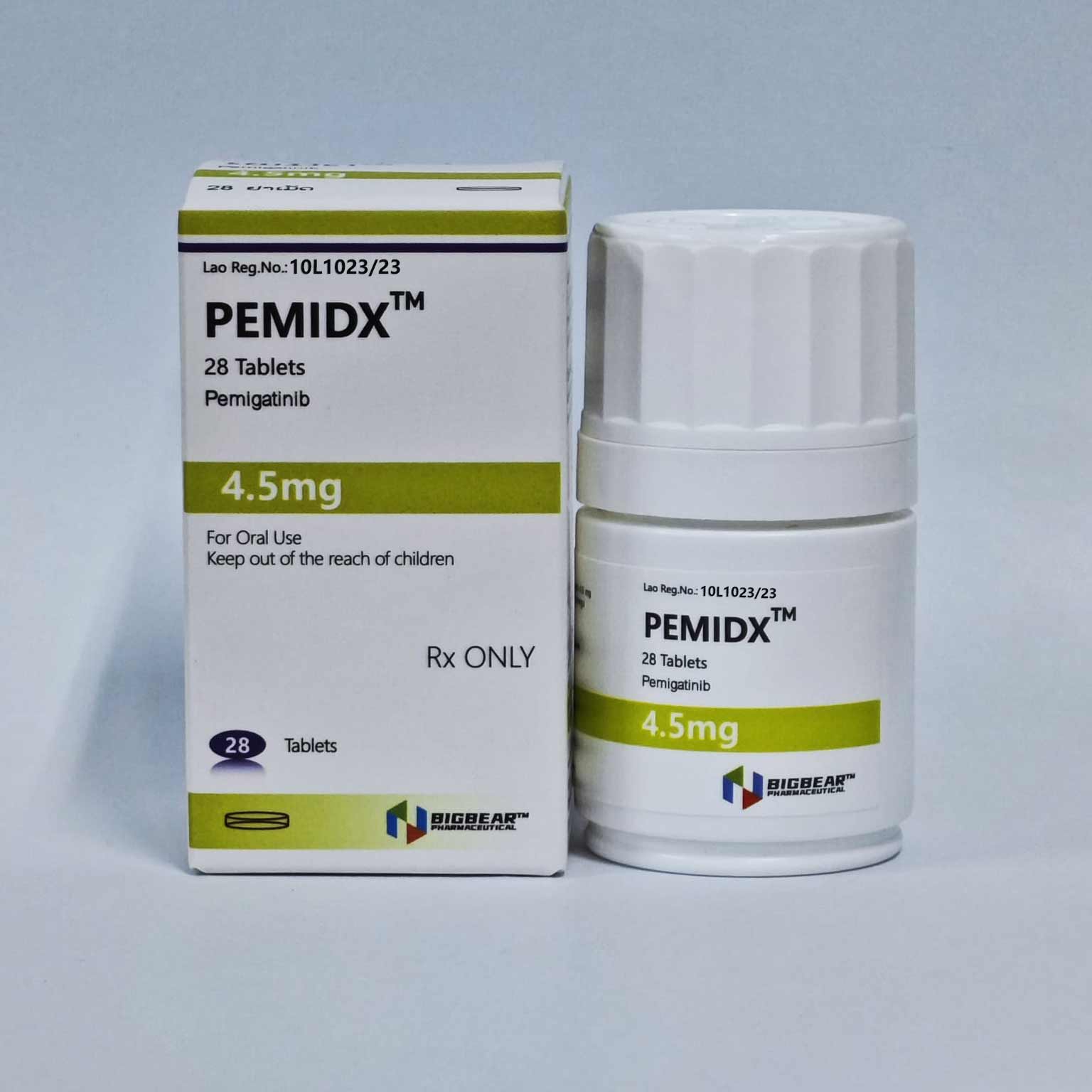PEMIDX,Pemigatinib 4.5mg
Manufactor:Bigbear Pharmaceutical Laos
Introduction:Pemigatinib prevents tumor growth and spread by inhibiting FGFR kinase in tumor cells. It is the first and only targeted drug approved by the US FDA for the treatment of cholangiocarcinoma. It is a small molecule inhibitor of fibroblast growth factor receptor (FGFR) 1, FGFR2 and FGFR3. It received accelerated approval in the United States in April 2020 for the treatment of previously treated, unresectable, locally advanced or Adults with metastatic cholangiocarcinoma and FGFR...
chat onlinePhone: +8562052137046
Recommended
- details
【Drug Name】
Name:Pemigatinib Tablets
Product Name: PEMIDX
【Specification】
4.5mg
【Indications】
PEMIDX is a prescription medicine that is used to treat adults with:
• bile duct cancer (cholangiocarcinoma) that has spread or cannot be removed by surgery:
o who have already received a previous treatment, and
o whose tumor has a certain type of abnormal FGFR2 gene.
• a type of blood cancer called myeloid/lymphoid neoplasms (MLNs):
o when it has come back or did not respond to treatment, and
o whose tumor has a certain type of abnormal FGFR1 gene.
Your healthcare provider will test your cancer for certain types of abnormal FGFR1 or FGFR2 genes and make sure that PEMIDX is right for you.
It is not known if PEMIDX is safe and effective in children.
【Recommended Dosage】
• Take PEMIDX exactly as your healthcare provider tells you.
• For cholangiocarcinoma, PEMIDX is taken in cycles of 21 days. Take PEMIDX 1 time each day for 14 days, followed by 7 days off treatment, to complete a 21-day treatment cycle.
• For myeloid/lymphoid neoplasms (MLNs), take PEMIDX 1 time each day.
• Take PEMIDX at about the same time each day.
• Take PEMIDX with or without food.
• Swallow tablets whole. Do not crush, chew, split, or dissolve PEMIDX tablets.
• You should not eat or drink grapefruit products during treatment with PEMIDX.
• Your healthcare provider may change your dose of PEMIDX, or may temporarily or completely stop treatment if you get certain side effects.
• If you miss a dose of PEMIDX, you can take the missed dose within 4 hours on the same day. If more than 4 hours have passed, do not make up the dose. Take your regular dose
of PEMIDX the next day at the usual time. Do not take more PEMIDX than prescribed to make up for the missed dose.
• If you vomit after taking PEMIDX, do not take another PEMIDX tablet. Take your regular dose of PEMIDX the next day at the usual time.
【Side Effects】
PEMIDX may cause serious side effects, including:
• Eye problems. Certain eye problems are common with PEMIDX but can also be serious. Eye problems include dry eye or inflamed eyes, inflamed cornea (front part of the eye), increased tears,
and a disorder of the retina (an internal part of the eye). You will need to see an eye specialist for a complete eye exam before you begin treatment with PEMIDX, every 2 months for the first 6 months,
and then every 3 months during treatment with PEMIDX.
o You should use artificial tears or substitutes, hydrating or lubricating eye gels as needed, to help prevent or treat dry eyes.
o Tell your healthcare provider right away if you develop any changes in your vision during treatment with PEMIDX including blurred vision, flashes of light, or see black spots. You may need
to see an eye specialist right away.
• High phosphate levels in your blood (hyperphosphatemia) and buildup of minerals in different tissues in your body. Hyperphosphatemia is common with PEMIDX but can also be
serious. High levels of phosphate in your blood may lead to buildup of minerals such as calcium, in different tissues in your body. Your healthcare provider will check your blood phosphate levels during
treatment with PEMIDX.
o Your healthcare provider may prescribe changes in your diet or phosphate lowering therapy, or change, interrupt or stop PEMIDX if needed.
o Tell your healthcare provider right away if you develop any muscle cramps, or numbness or tingling around your mouth.
The most common side effects of PEMIDX for cholangiocarcinoma include:
• hair loss • diarrhea • nails separate from the bed or poor formation of the nail
• feeling tired • change in sense of taste • nausea
• constipation • mouth sores • dry eyes • dry mouth
• decrease in appetite • vomiting • joint pain • stomach-area (abdominal) pain
• low phosphate in blood • back pain • dry skin
The most common side effects of PEMIDX for myeloid/lymphoid neoplasms (MLNs) include:
• nails separate from the bed or poor formation of the nail • hair loss • decreased appetite
• diarrhea • dry eyes • tiredness • anemia • stomach-area (abdominal) pain
• rash • constipation • dry mouth • nose bleeds • disorder of the retina
• pain in feet or hands • mouth sores • dry skin • indigestion • back pain
• nausea • blurry vision • dizziness • swelling in feet, legs, hands, or arms
These are not all the possible side effects of PEMIDX. For more information, ask your healthcare provider or pharmacist.
【Storage】
• Store PEMIDX at room temperature between 68°F to 86°F (20°C to 30°C).
Keep PEMIDX and all medicines out of the reach of children.

 中文
中文
